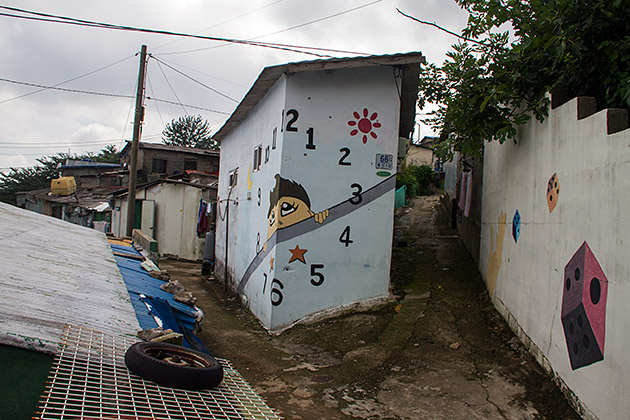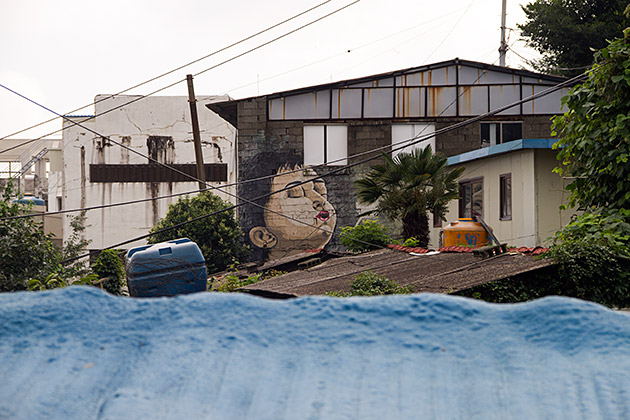Munhyeon-Dong Inner Town
Every once in awhile, we’ll choose a city excursion that’s a little off-the-wall, like an unknown neighborhood that doesn’t ever see tourists, picked almost at random. Often, these end up being among our favorite spots: Barracas in Buenos Aires comes to mind, as does Pampahasi in Bolivia. Other times… well other times, we end up in a place like Munhyeon-dong.

We had read about a project in Munhyeon-dong Inner Town which sought to redefine one of Busan’s most economically depressed areas using the transformative power of art. 47 murals were painted on the neighborhood’s houses, supposedly rejuvenating the area. The project won the Korean Public Design Grand Prize in 2008 and sounded similar to the open air art project in Gamcheon, which we really liked. Plus, it was in an area of the city which we hadn’t yet seen. Gotta be a winner!
Getting off the bus in Munhyeon, we started asking around how to get to the Inner Town project, receiving nothing but bewildered glares in response. We showed some pictures of the art we’d pulled off the internet, but nobody could help us. A feeling of defeat started to sink in; when residents don’t even recognize the art their neighborhood is supposedly famed for, it can’t be good.
We persevered and eventually found a woman who recognized one of the murals, and pointed up an insanely steep hill. This was during the midst of the summer monsoon season and though the rain had paused, the sun was strong and humidity nearly unbearable. By the time we reached the Inner Town, we were soaked in sweat. We realized almost immediately that this had been a wasted of effort. Munhyeon-dong is little more than a ghetto of cheap housing and their “art project” looked as though a group of moderately talented twelve-year-old kids had finally gotten their parents’ permission to draw on the sides of buildings.
Still, it wasn’t entirely a wash. The art wasn’t any good, but from up high there was a great view over the city. We could see Busan Port, the tower in Democracy Park and the Diamond Bridge. Even so, Munhyeon-dong Inner Town isn’t one of the essential experiences in Busan.



















Jurgen and Mike! You need some information about a ghetto of “cheap housing” in a city of Korea. Many times they are not underprivileged people or poor people. In some way they are privileged. Because they are waiting for city redevelopment under which they will get the right to get free apartment so they will make a huge fortune. A city government finds out how long they have stayed there to give the right since new comers are disqualified to the right to free apartment. And these days Korean city governments consider a ghetto as a historic legacy so they don’t want to completely get rid of that. Even if a city government decides to develop the ghetto, it tries to maintain about 20% of the ghetto as a historic legacy, which is also demanded by the ghetto residents during the final negotiation with a city government. Now Korean civil mentality is way above our imagination.
The wall art with the girl and the paper airplane and the one with the boy blowing the bubbles were pretty nice. I also liked the head of the dreaming baby and the head of the dreaming (?) Buddha emerging from the grass.
Maybe it wasn’t the day excursion you were hoping or dreaming for, but you did get to see what a typical neighborhood might look like, without the glitz and glamor of tourist fronts and big business. The murals did brighten up the neighborhood, and you did find that adorable park with all the cute birdhouses! No trip is ever a wasted effort: travel is all about seeing different sides of life, not just the sights laid out for tourists! I appreciated you documenting this side-trip. (And I’m not really one to talk: my blog is primarily about me visiting said tourist traps. I just wanted to point out that I enjoyed your post, and I get that same urge you do about going off the beaten path.) http://bit.ly/MyPGrl